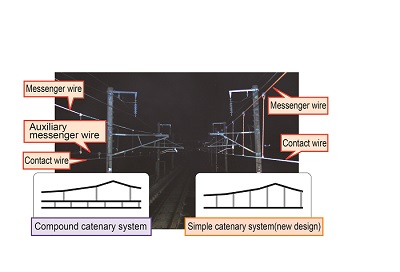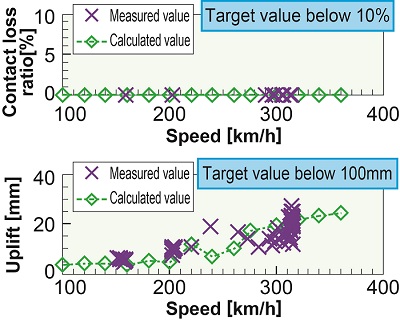14. Simple catenary designed for running speeds of over 300km/h
Auxiliary messenger wires on Japan’s Shinkansen line heavy compound catenary systems are gradually coming the time having to be replaced on a large scale. This is being used as an opportunity to replace incumbent installations with simple catenary systems on lines with running speeds below 300km/h. Interest has been growing in the meantime, to have simple catenary systems introduced on lines with running speeds of over 300km/h. Consequently, two types of simple catenary system designed for operating speeds over 300km/h were developed (Table 1).
Compared to heavy compound catenary systems, the problem with simple systems was that at speeds of over 300 km/h there is a risk for vertical pantograph vibrations to increase in the intervals between masts, which hinders current collection. As such, the overall tension of the catenary was increased above the normal simple catenary system level in order to increase the spring constant of the contact wire in the middle of the span between masts, thereby controlling the vertical vibration of the pantograph. Two simple catenary designs were developed, one for running speeds of 320/km/h and the other for 360km/h (Fig.1).
For the 320km/h design, in order to ensure that the wave propagation speed in the contact wire allows stable current collection at 1.4 times the standard speed, the selected contact wire had a cross sectional area of 170mm2 and was tensioned to 22.54kN.
For use at 360km/h, the cross sectional area of the selected wire was 130mm2 even though this reduces the maintenance margin against frictional wear, which was tensioned to 24.5kN.
The two designs were tested on a revenue line to verify their current collection performance. Results confirmed that the contact loss ratio and contact wire uplift were both within target values, and that the new design did not pose a problem for current collection. In addition, tests demonstrated that the state of frictional wear and workability of the new design were also satisfactory (Fig. 2).
Other Contents
- 12. Development of early restoration and reinforcement technologies for embankments damaged by natural disasters
- 13. Tunnel reinforcement method using improved performance ground reinforcement rock bolts
- 14. Simple catenary designed for running speeds of over 300km/h
- 15. Decision making system for economical mid-term track maintenance plans
- 16. Rail head defect repair method with reduced work time
- 17. Wireless train control systems designed for regional railways
- 18. Concrete deterioration control using hydrogen-ion type geopolymer
- 12. Development of early restoration and reinforcement technologies for embankments damaged by natural disasters
- 13. Tunnel reinforcement method using improved performance ground reinforcement rock bolts
- 14. Simple catenary designed for running speeds of over 300km/h
- 15. Decision making system for economical mid-term track maintenance plans
- 16. Rail head defect repair method with reduced work time
- 17. Wireless train control systems designed for regional railways
- 18. Concrete deterioration control using hydrogen-ion type geopolymer



